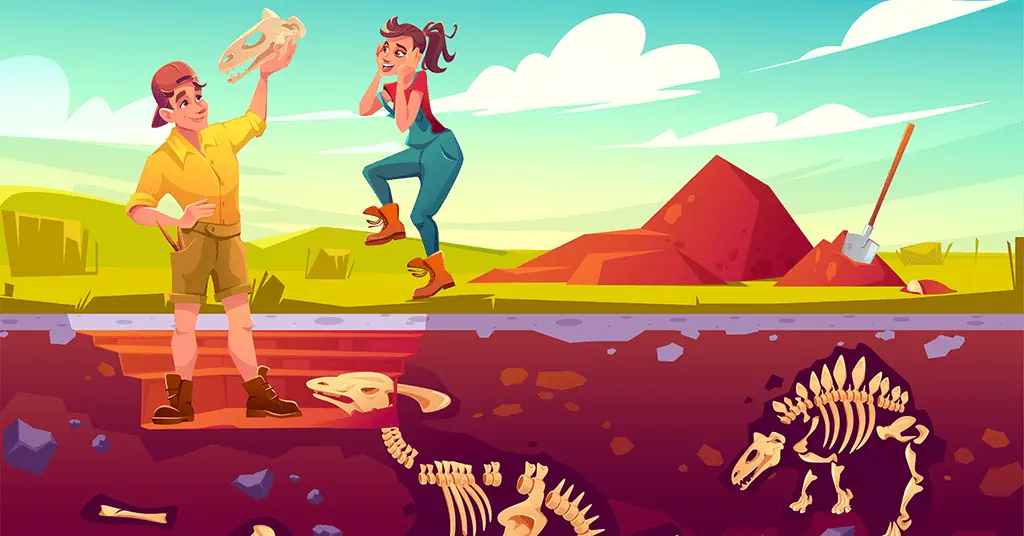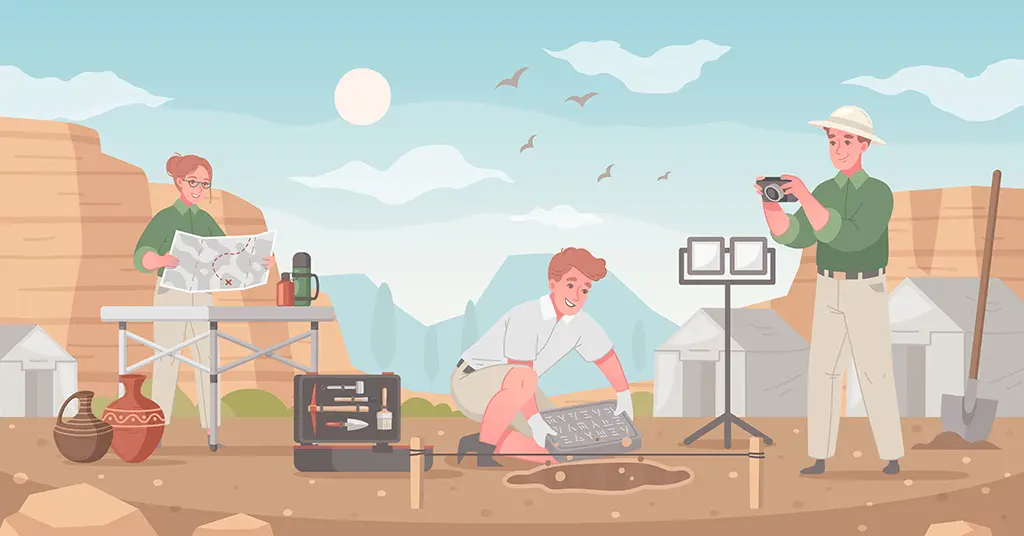AI Answer Evaluation Platform Live Now. Try Free Answer Evaluation Now
Prehistoric Archaeology
Prehistoric archaeology employs this technique to examine prehistory, the preliterate period of the human race’s history. More than 99 percent of human history may be discovered using ancient archaeology or prehistory as a subject of study. With writing only having originated in the Near East around 5000 years ago, the majority of the world’s earliest written books are significantly more recent. Ancient archaeology has made a great contribution to human knowledge by creating a chronological perspective on human history.

The antiquarianism that was widespread in the 16th, 17th, and 18th centuries is the basis of prehistoric archaeology. It wasn’t institutionalized as a subject until the emergence of uniformitarian geology in the 19th century. The assumption that the Earth had been built by ongoing natural geological processes rather than “catastrophes,” as was previously thought, served as the basis for rewriting human history. The true evidence that human history was much older than the 6,000 years implied by the orthodox scripture chronology was a miracle of ancient archaeology. It uncovered different indicators of human items mixed in with the bones of ancient animals.
One of the most significant components of ancient archaeology is the rigorous collection, classification, and analysis of data. This is performed by excavating, identifying, and documenting items and, in particular, chronologically structuring data.
The most significant component in ancient archaeology is time. Taking into mind that it originates from an age for which there are no records in history Chronologies, data processing, and time measurement and categorization have all garnered a lot of attention in ancient archaeology. In this regard, it is commonly acknowledged as a historical discipline in Europe.
However, chronology is not a goal in and of itself. The process of recreating and reinterpreting cultural history relies on it. Prehistoric archaeology is classified as a branch of anthropology in the United States. It has helped individuals grasp culture more widely and how crucial it is to develop comprehensive cultural systems. Utilizing structures, tools, and food leftovers, reconstructions based on archaeological data typically reflect technology and economics rather successfully. A variety of strategies have been developed for recreating ancient settlement patterns, resource usage, trade, and commercial networks. Palaeology, the study of how ancient cultures interacted with their environment, has developed and altered over time.
What is prehistoric archaeology?
Prehistoric archaeology is the study of human history prior to the advent of historical records. This assertion could be too broad given that human civilizations have sometimes succeeded in establishing sophisticated political and economic frameworks. Other ideological frameworks don’t have writing systems.
Prehistoric archaeology is most commonly described as the study of human hunter-gatherer communities prior to sedentary (permanent) settlements. The study of the period before historical events were documented is known as prehistoric archaeology. It is a discipline of study that investigates all pre-urban civilizations from throughout the planet. Archaeologists use a unique combination of analytical approaches to recreate the natural environments of the material remnants. The study of ancient archaeology brings to light the historical linkages between political stability and economic progress, which are tied to present cultural concerns.
The disciplines of biology, geology, and biological anthropology are exceedingly closely connected. A typical word for it is anthropological archaeology, owing to the sensitive clues and sophisticated patterns it shows. The end of the prehistoric era coincided with the Roman conquest of Western Europe in 43 AD, while it continued in other non-Romanized nations until the fifth century AD. Despite the fact that it ended substantially sooner in many regions, most notably Egypt at the end of the Third Intermediate Period, and much later in others, like Australia, The name “prehistoric” was introduced by the French scientist and archaeologist Paul Tournal in 1831 to define the discovery he had uncovered while exploring historic caves in the Bize-Minervois region of southern France.
The Foreign Quarterly Review reported the first use of the word “archaeology” in the English language in 1836. Christian Jürgensen Thomsen established the three-age system in 1836 in an effort to make sense of the chronology of ancient Europe. It is slightly older than the name itself. Prehistoric archaeologists define civilizations in terms of arbitrary contemporary titles owing to the locations of known habitation sites or the artifacts used, since there is no history to offer justification for names, places, or reasons. It is obvious that addressing groups rather than single individuals is simpler since these ancient people had no names at all in the archaeological record.
Prehistoric archaeology is a tricky area due to the scarcity of accurate data, and the arguments surrounding it have had a major effect on archaeological philosophy. Archaeologists are required to develop a critical viewpoint toward all accessible information and to take their own historical frameworks into account due to the diversity of perspectives on issues like the purpose of artifacts or sites, for example. The schools of archaeological philosophy known as structural functionalism and processualism have had a tremendous effect on ancient archaeology.
Characteristics and scope of prehistoric archaeology
Ancient archaeology necessitates time-consuming investigation and the finding of outdated items by nature. A vocation that demands both scientific research and artistic activity. in the Mesopotamian or Rajasthani desserts, for instance, or while toiling in the blazing heat. Working with genuine Eskimos on the frigid tundra of Alaska is part of it. Diving is necessary to access the Dwarka remnants on India’s western coast or the Spanish wrecks off the coast of Florida in order to understand the ancient Indian civilization. It also entails the difficult process of interpretation, which assists in our understanding of the importance of these items for the ancient human population.
This is how ancient archaeology combines a physical activity in the field, such as exploration or excavation, with an intellectual one that requires sifting through and analyzing the materials acquired in a lab and producing a report on the findings. It’s exciting to attempt to learn more about how people lived in the past.
Prehistoric archaeology is a field of anthropology that investigates prehistoric cultures. You may alternatively think of this section as past-tense cultural or social anthropology. This is because, unlike prehistoric archaeology, which focuses on physical evidence from ancient societies, cultural anthropology investigates both prehistoric and contemporary people.
Studying prehistoric archaeology may be utilized for a number of objectives
Ancient archaeology has grown into a subject of study with various academic subfields in the contemporary age. Each student generates their own thoughts and employs their own research techniques. The protracted prehistoric period’s archaeology differs from the historic era, as has already been described. Prehistoric archaeologists frequently specialize in either the earliest period or the later periods, as this chronological divide is frequently highlighted by additional sub-divisions (such as the Paleolithic, also known as the Old Stone Age or Early Stone Age, which dates from 2-3 million years ago and lasts until 10,000 years B.C.) or the later but earlier eras (the Hoabinhian, or Late Stone Age, which coexists with the older Hoabinhian period, the Mesolithic, The prehistoric period saw one of the most major revolutions in the previous fifty years. Numerous chances exist in ancient archaeology to explore items other than artifacts or other remnants of former civilizations or cultures. It may also be beneficial in specific archaeological investigations if the living circumstances of the past and present are sufficiently similar. Investigations are being done right now.
We commonly juxtapose items from the past with the present. Megalithism is one such extinct cultural activity that has vanished from the planet.
Diverse indigenous groups still perform it in the same style or in a slightly changed form in North-East India, mainly in Manipur, Meghalaya, and Nagaland. Some native communities still employ megalithic building methods. In light of this present activity, many academics with expertise in ethnoarchaeology are especially interested in recreating the previous lives of the local populations of these locations.
The purpose and goals of Prehistoric archaeology
The purpose of this discipline of archaeology is to grasp human history. The history of illiterate civilizations must be preserved to the greatest extent possible.It is a sociological study that lays more focus on civilizations and their interactions with the natural environment than it does on individuals, how they interact with one another, or society as a whole. It assists in our comprehension of the economic component of the human condition.
It fosters awareness, is incredibly instructive, and helps folks break free from the limits of their own place and time. Geology is more fascinating when the laws that regulate stratum development are known. People’s interest in geography and a sense of place are further sparked by exploring the historical and present-day conditions of temperature, topography, soil, vegetation, and animal life—all of which may be duplicated with the aid of the physical environment in which the archaeological remains are kept.
It is crucial to recognise the intricate relationships between human civilizations and natural ecosystems. It is closely related to aesthetic enjoyment because it is heavily reliant on artifacts and ecofacts and how they are perceived in terms of cultural progress.
Prehistoric archaeology aims to piece together the prior lives of prehistoric yet ancient cultures by using material remains unearthed as artifacts and ecofacts.
Curiosity is necessary to properly understand how individuals utilized their environment and lived. It also seeks to comprehend how and why their way of life and material culture developed into the shapes that they did. This covers how and why their conduct took the forms that it did. It demonstrates interest in the cultural development processes (C-Transforms) by completely defining them.
Techniques in Prehistoric Archaeology

Initially, ethnoarchaeology. This discipline of modern archaeology has evolved enormously. To interpret the archaeological records or remains, understanding is needed. More information is offered on how it was made and how it came to be. Site development techniques are becoming the subject of increased investigation. Here, ethno-archaeology—the study of modern people and their material culture with the purpose of bettering our understanding of archaeological remains or records—enters the picture in a novel way. For instance, Lewis Binford’s research on modern hunter-gatherer butchery practices among the Nunamiut Eskimo of Alaska has provided him with a wealth of new insights into how archaeological artifacts may have formed, allowing him to reexamine the animal bones that very early humans in other parts of the world left behind.
Additionally, these studies are not restricted to smaller people, more primitive civilizations, or groups. Let’s take the Tucson Garbage Project as an example, which was launched in Tucson, Arizona, by William L. Rathje. It requires removing trash from an area of the city’s trash cans and carefully categorizing every item inside them in a lab. Thus, the extremely uncomfortable task has revealed some intriguing and shocking information concerning the consuming patterns of urban people in the present, and the tactics applied are utterly archaeological.
Archaeology is tied to the environment. Another vital field of investigation is environmental archaeology. It is an interdisciplinary method where archaeologists and experts from other disciplines look at how societies have utilized plants and animals to adapt to the continuously changing environment.
Environmental archaeology has expanded dramatically throughout the previous several years. It regards people as interacting with other organisms in an ecosystem or ecological system as a part of the natural world. All variables of life, including latitude and longitude, landforms, temperature, and vegetation, are controlled by the environment, which in turn determines animal life. And these features, regarded as a whole, account for how and where people have lived, or at the very least, what they have been doing up until quite recently.
- With a few important exceptions, archaeologists paid little attention to eco-factual information until recent decades. Sites were examined more or less as a self-contained bundle of data rather than being studied in the context of the landscape. It is becoming increasingly understood that it is necessary to view places in their context and take into consideration the geomorphological and biological processes occurring both within and outside of them. Instead of being continuous or uniform over space and time, the environment is now seen as a variable.
- Because of the poor preservation of multiple types of evidence and the skewed samples we extract, we can never determine the “real” facts of the historical events. The goal must simply be the best estimate that is now available. No one method will give adequate results. To produce a composite image, it will be necessary to apply as many approaches as there are data and outcomes, as all of them are biased in some way. Despite these challenges, the objective of environmental reconstruction is crucial. We first need to grasp how they lived before we can fathom how they behaved both as individuals and as a collective.
- Another branch of study needing both substantial competence and bravery is marine archaeology, commonly referred to as “undersea archaeology.” In general, it is supposed to have had its first great surge during the winter of 1853–1854, when a very low water level in the Swiss lakes revealed large quantities of wooden posts, pottery, and other goods. From the early studies, which utilized crude diving belts, it has grown into a practical complement to work on land. It includes wells, sinkholes, and springs (such as the large sacrificial well at Chichen Itza in Mexico), submerged lakeside settlements (such as those in the Alpine region), and marine sites such as shipwrecks, sunken harbors (such as Caesarea in Israel), and downed cities (such as Port Royal in Jamaica and Dwarka in India), as well as wells, sinkholes, and springs.
Over the last 50 years, it has grown into a highly scientific effort that produces historical time capsules in the form of shipwrecks and other structures that give unique insights into ancient life on land and at sea. Divers may now explore areas at previously unreachable depths and stay down for a lot longer thanks to recent improvements in scuba diving equipment, new submersible vessels, and miniature submarines. Because of this, during the preceding several decades, both the pace and breadth of discovery have substantially grown.
Conclusion
Ancient archaeology is the study of ancient civilizations without written records. The scant details about these societies’ ways of life that we do know may be obtained from their artifacts. For example, the only artifacts accessible to archaeologists investigating the Clovis people are stone tools and arrowheads, popularly known as projectile points. The distinctive projectile points were originally uncovered near the town of Clovis, New Mexico, from which the civilization gained its name. According to the so-called Clovis points, the Clovis people were among the continent’s early immigrants. According to studies, Clovis points date back to almost 13,000 years ago.
A branch of ancient archaeology is paleopathology. Paleopathology is the study of sickness in ancient cultures. Paleopathology is a discipline of historical archaeology. Paleopathologists may examine the incidence of certain diseases, the absence of certain illnesses in specific geographic regions, and how different civilizations dealt with sickness. Paleopathologists investigate the history of a disease to help us understand how current problems develop. Paleopathologists may be able to grasp data about someone’s overall health. For instance, by studying the teeth of those people, paleopathologists may uncover the kind of food that ancient humans ingested, how often they ate, and what nutrients those meals contained.
Suggested Articles
Suggested Readings
- Agrawal, D. P. and A. Ghosh (eds.). 1973. Radiocarbon and Indian Archaeology. Bombay: Tata Institute of Fundamental Research. Barnard, Alan. 2016.
- The Evolution of Language: An Anthropological Approach Language in Prehistory. Cambridge: Cambridge University Press. Clark, Anthony. 2003.
- Seeing Beneath the Soil: Prospecting Methods in Archaeology, New edition. New York: Routledge. Clark, J. G. D. 1965.
- Radiocarbon Dating and the Spread of Farming Economy’. Antiquity, 39: 45–48. Kulkarni, A.C. 2015.
- Offshore Technology and Marine Archaeology.’ In A.S Gaur and Sundaresh (ed.).
- Recent Researches on Indus Civilization and Maritime Archaeology in India. Delhi: Agam Kala Prakashan. Laet, S.J. de (ed.),A. H. Dani, J. L. Lorenzo Gieysztor and R. B. Nunoo (co-eds.). 1996.
- History of Humanity, Volume 1: Prehistory and the Beginnings of Civilization. UNESCO. London: Routledge. Lubbock, John. 1865. https://unesdoc.unesco.org/ark:/48223/pf0000119149
- Prehistoric Times: As Illustrated by Ancient Remains, and the Manners and Customs of Modern Savages.
- London and Edinburgh: Williams and Norgate. Renfrew, C. and P. Bahn. 2008.
- Archaeology: Theories, Methods and Practice. 5th edition. London: Thames and Hudson. Schmidt, A. 2007.
- Archaeology, magnetic methods’. In D. Gubbins and E. HerreroBervera (eds.) Encyclopedia of Geomagnetism and Paleomagnetism: Encyclopedia of Earth Sciences Series. Heidelberg, New York: Springer: 23-31




